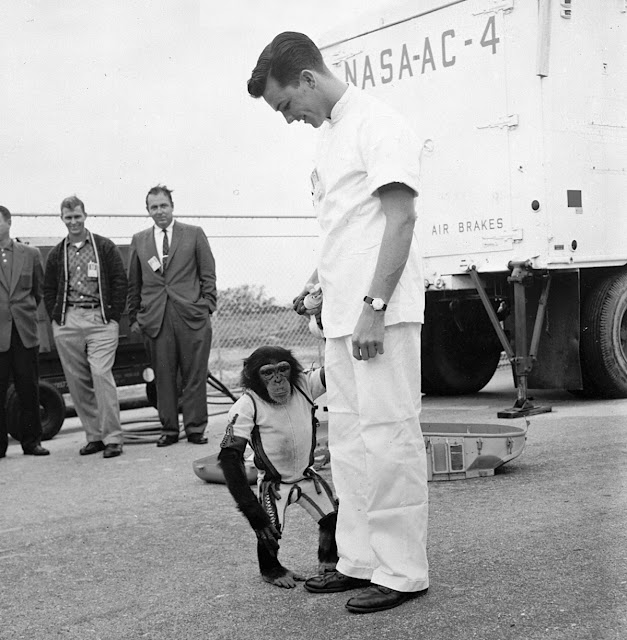On the morning of January 31, 1961, in south Florida, a 5-year-old chimpanzee dubbed “Ham” by his handlers ate a breakfast of baby cereal, condensed milk, vitamins and half an egg. Then the unassuming 37-pound primate went out and made aeronautic history: Aboard a NASA space capsule, traveling thousands of miles an hour almost 160 miles above the Earth, he became the first chimp in space. The success of Ham’s flight helped ratchet up even further the already frantic contest for scientific and space supremacy between the U.S. and the Soviet Union and briefly made Ham something of a star.
 |
| Ham the chimp poses with a newspaper announcing his successful trip to space, 1961. |
Beginning in July 1959, the two-year-old chimpanzee was trained under the direction of neuroscientist Joseph V. Brady at Holloman Air Force Base Aero Medical Field Laboratory to do simple, timed tasks in response to electric lights and sounds. During his pre-flight training, Ham was taught to push a lever within five seconds of seeing a flashing blue light; failure to do so resulted in an application of a light electric shock to the soles of his feet, while a correct response earned him a banana pellet.
The results from his test flight led directly to the mission Alan Shepard made on May 5, 1961, aboard Freedom 7.
On January 31, 1961, Ham was secured in a Project Mercury mission designated MR-2 and launched from Cape Canaveral, Florida, on a suborbital flight. Ham’s vital signs and tasks were monitored by sensors and computers on Earth. The capsule suffered a partial loss of pressure during the flight, but Ham’s space suit prevented him from suffering any harm. Ham’s lever-pushing performance in space was only a fraction of a second slower than on Earth, demonstrating that tasks could be performed in space. Ham’s capsule splashed down in the Atlantic Ocean and was recovered by the USS Donner later that day. His only physical injury was a bruised nose. His flight was 16 minutes and 39 seconds long.
On April 5, 1963, Ham was transferred to the National Zoo in Washington, D.C. where he lived for 17 years before joining a small group of chimps at North Carolina Zoo on September 25, 1980.
After his death on January 19, 1983, Ham’s body was given to the Armed Forces Institute of Pathology for necropsy. Following the necropsy, the plan was to have him stuffed and placed on display at the Smithsonian Institution, following Soviet precedent with pioneering space dogs Belka and Strelka. However, this plan was abandoned after a negative public reaction. Ham’s remains, minus the skeleton, were buried at the International Space Hall of Fame in Alamogordo, New Mexico. Colonel John Stapp gave the eulogy at the memorial service. Ham’s skeleton is held in the collection of the National Museum of Health and Medicine.



















0 comments:
Post a Comment